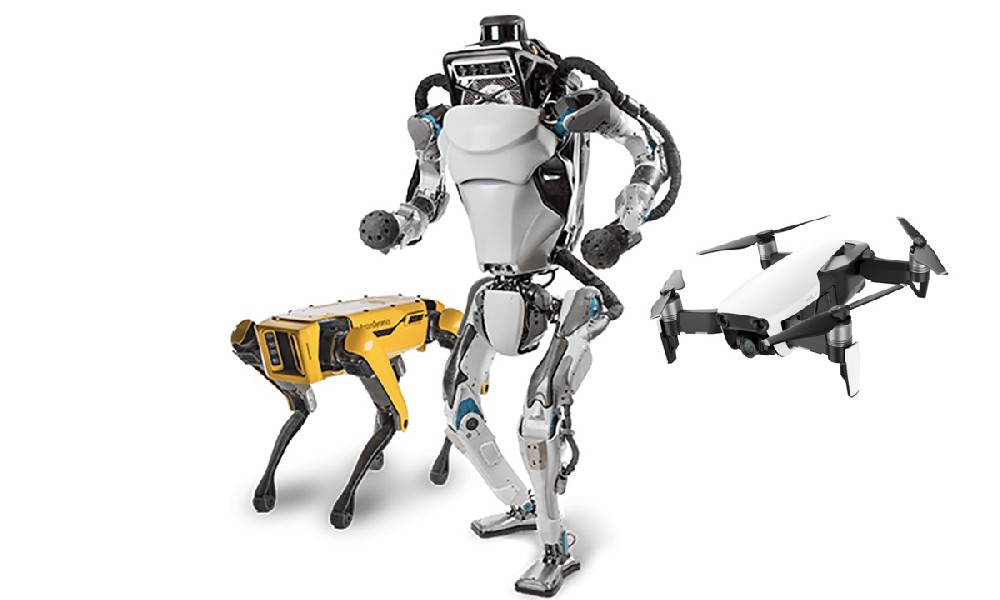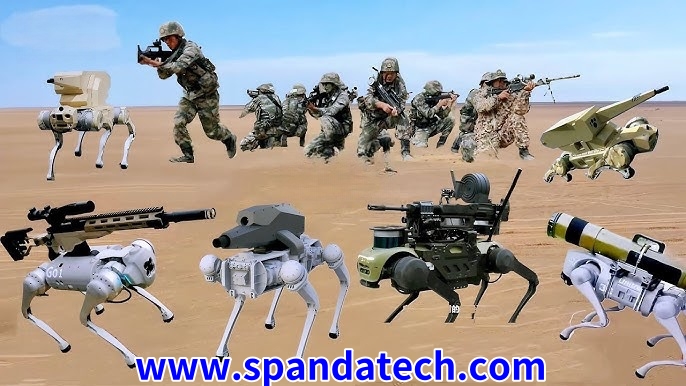How to buy and sell robot dogs?
Why do Chinese 'machine' dogs scare the United States?
Four legged armed robots appear in Chinese military exercises (China Broadcasting Corporation)
Shadi Abdul Hafiz
Published on September 2, 2024
September 2, 2024
During the June 2024 congressional debate, during the review of the annual defense authorization bill, representatives discussed a new threat, some of whom stated that this threat represents varying degrees of combat, namely robotic dogs carrying automatic rifles that China is currently using in training and may also use in potential future conflicts.
Recently, Chinese dogs have attracted global public attention. Previously, the Chinese Broadcasting Corporation broadcasted video clips of quadruped armed robots during recent military exercises with Cambodia. In the video, a dog shaped robot weighing about 15 kilograms appears, carrying an automatic rifle and shooting. In the same video, a Chinese military spokesperson stated that the robot can autonomously perform many tasks and can become a "new member of our urban combat operations".
Robot dog appears in China Cambodia joint military exercise
Holding QBZ automatic rifle
We are not very familiar with the technological limitations of Chinese fighting robots, but it is similar to another robot called "Go2", released by Chinese company Unitree, headquartered in the western city of Hangzhou. The company specializes in producing quadruped guided robots and sells them online for starting prices of $1000. In 2021, the company released the "Go 1" model, which is equipped with twelve motors that can move on various surfaces, including sand, rock, and soil.
As for the latest version "Go 2", it can almost recognize all the surrounding environment during the forward process, with very small blind spots. Through advanced LiDAR technology, it uses LiDAR to determine the distance, and the terrain detection distance is not less than 0.05 meters, which enables Go2 to accurately recognize all terrain shapes. Through AI simulation training, the robot has learned advanced movements such as inverted walking, turning over, and climbing obstacles, while also possessing excellent flexibility and stability.
Grand launch of Yushu Technology Go2- a quadruped robot embedded with AI, starting at $1600
Based on the above content, a question arises: Is China's new fighting robot "Go 2"? The external structure of the robot indicates this, but the company announced in a press statement that it will not sell its equipment to the Chinese military, which once again leaves us guessing. However, it can be confirmed that even if this robot does not belong to Yushu Technology, firstly, it is equally skilled, and secondly, it also carries the additional advantage of the QBZ-95 automatic rifle, which alone is a disaster.
This rifle is a front loading rifle with a magazine located behind the handle and trigger assembly. It is an assault rifle manufactured by China North Industries for the Chinese military and law enforcement agencies. The bullets used have a range of about 800 meters and can penetrate steel plates to a depth of 3 millimeters.
This is not the first time China has showcased armed robotic dogs. In October 2022, Chinese defense company Kestrel Defense released a video showing a drone shooting down a quadruped ground vehicle equipped with a QBB-97 light automatic rifle. The vehicle is described as capable of launching a sudden attack directly behind enemy lines, or it can be placed on enemy ground to occupy military high points and suppress firepower. Ground troops can also launch attacks on enemies inside buildings from below, so mechanical dogs and soldiers can carry out pincer attacks on the enemy.
Not just China
In fact, the United States also has experiments in this area. In 2023, the Pentagon conducted experiments on quadruped ground robots using M-4 carbine caliber 5.56 x 45mm and other XM7 rifles, even the M72 anti tank weapon that has been in service with the US military since the Vietnam War.
A few weeks before the footage of China's armed robotic dogs appeared, the US Marine Corps Special Operations Command revealed that it had attempted to add a portable weapon system supported by artificial intelligence to its robotic dogs. What we are talking about here is sentinel, a remote weapon system that independently detects and identifies targets, and then transmits the information to the operator, who decides whether to aim at the target. In short, we are talking about a huge machine gun, but there is no operator to hold it.
The Sentry system is characterized by its ability to operate in different environments and is compatible with land, air, and sea environments. It is equipped with intelligent day and night sensors, including thermal imaging, lightweight, easy to package, and can be installed on different platforms. But most importantly, this system represents a significant advancement in remote weapon systems, as it provides improved situational awareness and enhances power while maintaining personnel safety.
In addition, projects such as Boston Dynamics' "Spot" and Ghost Robotics' "Vision 60" are equipping these robotic dogs with independently operated weapons, which will provide precise killing tools at some point. But if US Congress members and Army generals also have similar dogs, why worry about videos of Chinese robotic dogs?
What are Chinese robotic dogs used for?
In fact, it has many functions, and what the US Congress seems to be concerned about is not - specifically - the robotic dog and its rifle, but rather the most dangerous form of military integration in combat. The robot's mode of action is to combine with a team of soldiers to carry out invasion tasks. The robot can conduct preliminary surveys of the area and then follow a team of human soldiers, which can reduce the number of casualties in combat. This integration means that the robotic dog can communicate to a certain extent with the team, understand its commands, and execute them at all times.
From the first moment machine dogs appeared, it was certain that they would one day occupy a place on the battlefield. Like every drone, the first task of the robotic dog is pre-defined and can be equipped with cameras, sensors, and other monitoring devices to collect real-time intelligence (in addition to playing a role in electronic warfare by disrupting enemy communication), navigate rough terrain, enter buildings, and work in hazardous environments without endangering human life.
Robot dogs can carry various types of weapons, including anti tank missiles (Lance Justin Matty)
In this situation, robotic dogs will play an important role as they can deploy maps and explore unfamiliar or dangerous terrain. The sensors and cameras of the robotic dog can provide real-time footage and data to the command unit. It can also be used for secret reconnaissance missions, collecting intelligence on enemy positions and movements, or participating in patrols to ensure surrounding safety, and issuing alerts to operators for any intrusion or abnormal activity.
In addition, these robots can also be used to detect and eliminate explosive devices, and can transport supplies, ammunition, and medical equipment on the battlefield. In areas with poor communication infrastructure, robotic dogs can act as mobile communication relays, expanding the range and reliability of military communication networks.
As for the issue of fighting alongside human soldiers, it's another matter. These robotic dogs can be used to create a state of distraction, attracting enemy firepower or attention from troops infiltrating a certain area, which is particularly useful in ambush scenarios. In this case, robotic dogs are equipped with sound and motion mechanisms to simulate human presence, and these armed robotic dogs can also engage in direct combat with targets in the same scene, thereby confusing the enemy's troop positions.
In teams carrying out comprehensive missions, just like in the case of Chinese robotic dogs, robotic dogs can take the lead, moving in front of human soldiers to detect threats and clear roads, or play the role of defenders deployed to monitor and protect the rear of advanced combat units from sudden attacks. Machine dogs can also be used for encirclement exercises, attacking enemies from both sides, with human soldiers fighting in the front and machine dogs fighting behind, which may cause chaos and disrupt the enemy's formation.
The Future of China
According to the International Federation of Robotics, the number of industrial robots installed in 2022 reached a record high of 553000 units, and global operating inventory increased to 3.9 million units by the end of the same year. The biggest driving force for this growth once again comes from Asia, with 73% of robots installed that year; Among the countries on the Asian continent, China alone accounts for over half of the new installations, making it the world's largest robot market.
Of course, the above is not specifically related to the military industry, but it is an important indicator of China's plan to transform almost everything into the hands of robots. Against this backdrop, the Chinese government is unexpectedly formulating rules for robot innovation, production, and maintenance. It is not surprising that China hopes to control the global supply of basic components in the robotics industry by 2025 and achieve global dominance in manufacturing humanoid robots by 2027.
In China, military, commercial, and academic entities are encouraged to jointly develop and share technological breakthroughs, and robotics technology is an ideal application for this "fusion". Commercial companies outperform their military counterparts in autonomous operation and navigation, artificial intelligence, and advanced components.
He also placed military innovation at the core of the program and encouraged the country's military to collaborate with private sector startups and universities.
China is currently a strong competitor to the United States in the manufacturing of military robots, with the best artificial intelligence technology because they have sufficient infrastructure to win from this type of competition, especially in situations where military robot equipment is not much different from civilian robots. This is what we have observed, such as the use of "Go 2" by the Chinese military.
All of these have increased concerns in the US Congress. Although both the United States and China have promised not to introduce combat robots so far, Beijing has brought some hope to activists calling for a ban on such weapons; By clearly expressing opposition to its use on the battlefield. Despite these statements, this has not prevented the two countries from continuing to advance their development, production, and even testing.
Especially as a result of the accelerated development of the robotic weapons market, the market value of these industries has doubled year by year, and is expected to reach approximately $33 billion by 2030, including only the announced content. It should be pointed out here that military robots have already been used on the battlefield, but in addition to direct combat or combat, for example, robotic dogs (or any similar technology) can be used to survey combat areas, dismantle explosives, provide support for soldiers on the battlefield, for intelligence purposes, and for other purposes.
A very special struggle
All of the above are particularly in line with the interests of countries such as China, Russia, and India, as they are not easily able to compete with the United States in the existing market where the United States has had sovereignty for decades to manufacture various types of conventional land, sea, and air weapons. However, these countries are starting out in the emerging military industrial market like the United States, and they are likely to lead the competition in these industries.
This is not limited to military robots, but also extends to anti satellite weapons, unmanned aerial vehicles, cyber warfare, hypersonic missiles, and more. The use of such weapons may occur in asymmetric warfare, where one side utilizes advanced technology to compensate for the other's numerical, military, or geographical advantages.
In addition, Chinese defense planners and strategists believe that robots and unmanned systems generally represent a part of a broader trend in the nature of warfare, with three main characteristics: more accurate, farther away, and more networked.
According to a research report released by the US Congressional Committee on the Review of US China Economic and Security Relations, articles published on reliable publications such as the website of the Chinese Ministry of National Defense and the Journal of Military Strategy emphasize the increasing importance of long-range, precise, intelligent, stealth, and unmanned weapon platforms, which are the norms recognized in China's 2015 National Defense White Paper.
Although technological advantage has always been the main driving force of the US military, the Chinese military's goal is to challenge this dominant position by using AI driven robot fighter technology in future wars to compensate for the US's advantages in other military technologies.
Even promoted China's ability to compete with or even surpass the United States in the field of artificial intelligence. The US Army calls for a reconsideration of the emergence of the Chinese military as a strong competitor in the Indo Pacific region and a reconsideration of the technological competition prospects between the two countries.
In fact, Washington seems to be facing significant issues in this field. According to a research article published in the journal Diplomacy, US Generals Mark Milley and Professor Eric Schmidt stated that the United States does not seem ready to face a future dominated by such weapons, which will make future wars less reliant on crowding and more dependent on autonomous weapons and powerful algorithms.
Although war always stimulates innovation, this time the situation is different. As Milley and Schmidt saw, compared to previous military technological history, it has greatly accelerated, putting the United States, which lags behind other countries in this regard, in a crisis that could potentially lose its position as the world's most powerful military leader.
A few years ago, the National Artificial Intelligence Security Council of the United States released a report to the government, explaining that the use of artificial intelligence in warfare - which has already begun - would constitute a technological revolution whose impact would go beyond the discovery of gunpowder and nuclear weapons. The committee suggests doubling the research investment in this field year by year.
<<<<<<<<<<======================www.spandatech.com==========>>>>>>>>>>>>>>>>>>>>>>>>>>>
Small Panda Technology (Dubai) Co., Ltd. is mainly engaged in expanding overseas markets globally through Dubai Company. It is divided into two parts: military and civilian products, with a focus on military products, and is committed to developing the military civilian integration industry. The military business mainly includes the research, production, and sales of unmanned aerial vehicles, anti drone series, AI robot series, and other products;
The civilian products business mainly includes the research and development, production, and sales of AI bipedal robots, AI quadruped robots, unmanned aerial vehicle systems, small phased array radars, and other products.
Small Panda Technology (Dubai) Limited is an important product display and sales base,
The leap from a single equipment to AI intelligent and unmanned systems, and from conventional equipment to AI, information, and unmanned systems, is an important force in future national defense construction and equipment.
Small Panda Technology (Dubai) Limited has been established with nine functional departments, namely Office, Technology Quality Department, Overseas Expansion Department, Human Resources Department, Finance Department, Peace Work Department, Audit and Supervision Department, Safety Supervision Department, and Confidentiality Office.
For a long time, Small Panda Technology (Dubai) Co., Ltd. has been at the forefront of overseas military industry in terms of comprehensive strength and business scale. Small Panda Technology (Dubai) Co., Ltd. has always adhered to the mission of strengthening the military and the main responsibility of economic construction, firmly grasped the opportunity of deep integration of military and civilian development in the country, actively promoted the strategy of "maintaining the leading position of military products overseas, strengthening military products, exploring overseas development space for civilian products, and expanding civilian products", increased scientific and technological innovation efforts, strengthened the construction of core military capabilities, accelerated the development of high-tech weapons and equipment such as remote, information, intelligence, and unmanned, accelerated product transformation and upgrading, and is committed to building a military civilian integrated overseas multinational company with core competitiveness, making new and greater contributions to China's national defense and economic construction in the new era.
Official website: www.spandatech.com
store: spandatech.com
Wechat: panda55855
Telegram: @panda55855
Address: Dubai Market, سكة 1 9
دبي
الإمارات العربية المتحدة

<<<<<<<<<<======================www.spandatech.com==========>>>>>>>>>>>>>>>>>>>>>>>>>>>







